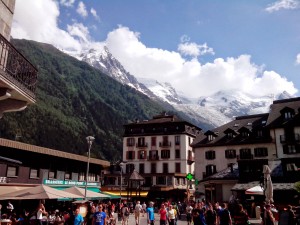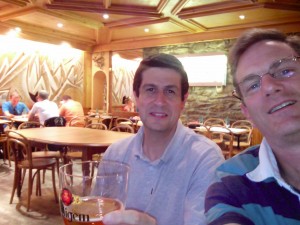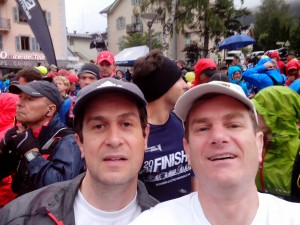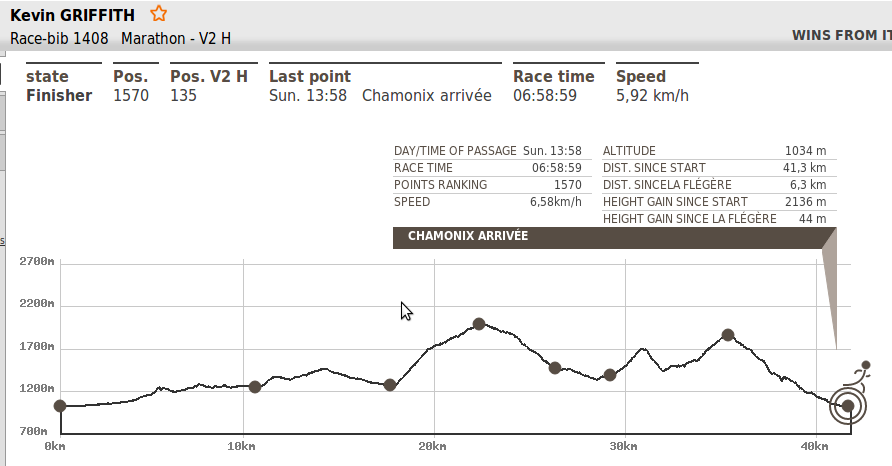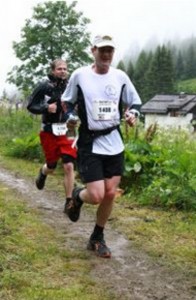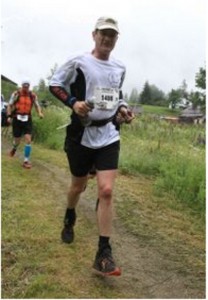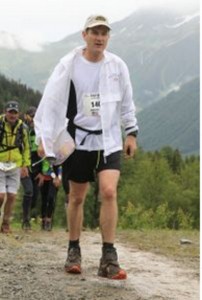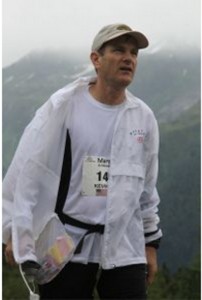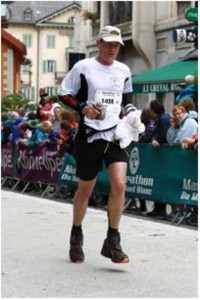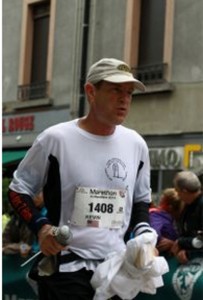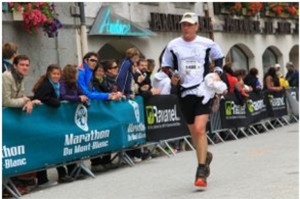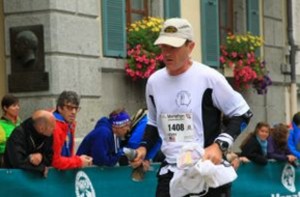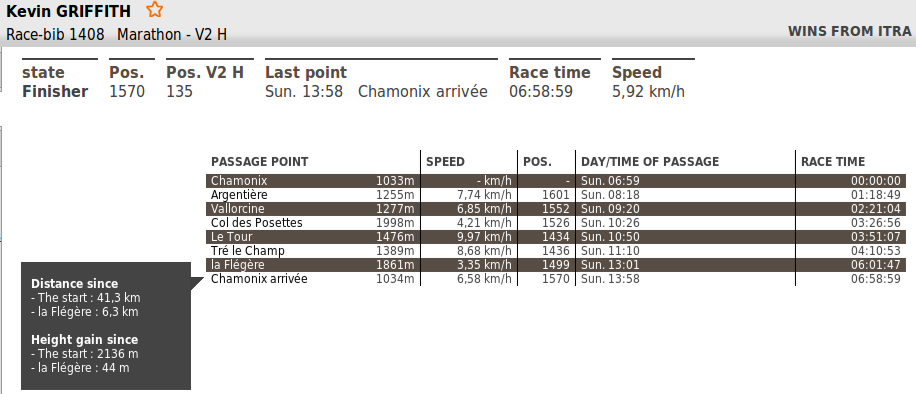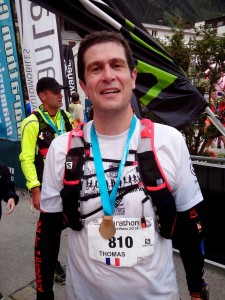If you ever get bored with running marathons on city streets just sign yourself up for the Marathon de Mont-Blanc. I guarantee you an unforgettable challenge over terrain best fit for mountain goats. To estimate your finishing time, just double your normal marathon time.
I was able to finish this one in 6:58:59. The stats:
- distance: 43.23 km (26.86 mi)
- pace: 9:41/km (15:34/mi)
- elevation gain: 2,343 m (7,687 ft)
- calories burned: 2,962
- 135th place out of 232 in my age category
- 1569th out of 2291 total runners
Thomas and I arrived at Chamonix the day before the race to pick up the pre-race packet. Here is a photo of Mont-Blanc from Chamonix.
We had a few hours to kill after picking up our race numbers so we visited the sports shops. I bought a collapsible water bottle. We came to the Salomon shop and there was a crowd gathered around one of the world’s top trail runners, Kilian Jornet who was signing autographs. He was the winner of the vertical km race the day before and would go on to win the marathon as well in something like 3:23.
We got some dinner in a local sports bar and watched a world cup soccer match while properly hydrating as you can verify in this photo.
We were in a convenient hotel that was just a few hundred meters from the start line. Wake up came at 5:30. I ate a banana and an energy bar, got my gear ready and peeked out the window to see light rain falling at dawn. We made our way to the start where it was still raining and about 12°c. I recorded a video. Start line video.
Here is the course profile with my final stats.
The first 10 km were runnable and a good warm up. There was space to run despite the 2100+ runners. Here’s a photo showing what it was like. That’s Thomas just behind me.
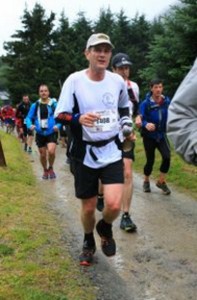
Just after the water stop at 10k we ran into a choke point where the trail started uphill on a single track. It took about 10 minutes before we were able to advance at a walking pace up the hill. Thomas and I got separated in the mass of runners waiting their turn to go up the trail.
It was only 7 kms to the next aid station but it took about an hour to get there given the waiting and single track. There was a nice downhill stretch that was easy to run. Here are a couple pics from this section.
At the aid station I ate some banana, crackers, chocolate and filled my hand-held bottle. As you can see in the photos, I didn’t use my backpack with camelbak. The aid stations were close enough together so that I didn’t need to carry more than the 750ml bottle. Also, on a rainy, cold day I didn’t need to hydrate like is necessary when it’s hot. I had a belt that has pockets for gel paks. My shorts have a pocket where I kept a little plastic sack containing salt pills and energy tablets. I put one energy tablet in each refill of my water bottle. The tablet dissolves in about 5 minutes. I take in a salt pill about every 2 hours. This keeps me from getting cramps. In long training runs and races I’ve never had cramps since I’ve been using the salt pills.
Other equipment I had with me: gaiters, a windbreaker that folds up into one of it’s pockets and has a strap that I put around my waist. Inside the windbreaker, I had the obligatory space blanket and whistle. On my arm I had a strap with pocket to put my telephone. To keep my arms warm I had sleeves that are very practical. If you get hot you can just slide them down to the wrists or take them off and put in a pocket.
I use my Garmin sports watch to record race data: pace, distance, elevation, etc. The battery only lasts 5 hours so I hooked up my portable duracell charger at the start of the race. The cord wraps around my arm and is held in place with a sweat band. When it beeps with low battery, I take the charger out of my back pocket, connect it, turn it on, and carry it in my hand. The watch recharges in about 30 minutes. This system works well for me.
After the second aid station, the 4.6 km climb to the Col des Posettes begins. It’s a steep 717 meter climb on single track, over rocks, roots and slippery difficult terrain. Three quarters of the way up you break out of the forest into the open on a ski access road. Up until then the rain was keeping us cool, but when we hit the open area the wind and rain hit us head on. A lot of people stopped and put on their windbreakers. This looked like a good idea so I did the same. As the the climb kept going up and up and the wind and rain continued, the temperature and wind-chill went down and down. It took me about an hour to do the climb. At the top there was a water stop to refill my bottle which I did real fast. Elevation is 2000 meters at the pass and my only thought was to get out of the cold and down into the valley as quickly as possible. Photos of me near the crest:
The next 6 km were downhill on a rocky access road and I cruised down at a good pace (10km/hr), being careful not to get out of control. Near the bottom I met a 4×4 ambulance vehicle making it’s way up to rescue somebody. I have to admit that the conditions were a bit extreme up there.
In the valley there was another aid station and I fueled up again and was still feeling relatively good after 29 km.
Next came the steepest, most rugged part of the race. There were two climbs and an incredibly difficult descent between them. I suffered mightily. A lot of people had poles with them. Supposedly it helps to push with your arms on the climb and helps with stability on the descents. With the slippery, muddy, rocky trail, I can see how poles would help. Somehow I negotiated the terrain without falling. These two hills seemed never-ending. They were in the forest and the end was never in sight. All along, I was being passed by other runners/walkers. Going up, everyone was walking. Finally I broke out of the tree line and saw the summit at a ski station above me. I went around the small lake and pushed hard up to the top where there was food and drink. I felt kind of dizzy and stunned at this point.
There were 6.4 km left to get back down into Chamonix. My legs were no longer fresh and the descent was not over easy terrain. Again, I had to let lots of runners pass me, completing those last 6.4 km in 54 minutes. In Chamonix, the streets were lined with a good crowd of people.
Here are my splits:
At the finish there were lots of cheers, with music and it was a great feeling to cross the finish line.
I wasn’t sure if Thomas was in front of me or behind me. I recovered a bit and looked around the finish area. He arrived a little later and I snapped this photo.
That was without doubt the toughest marathon we ever ran. It’ll be hard to find a more difficult one considering the terrain and conditions.

